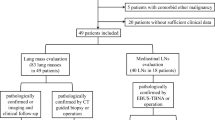Abstract
Purpose: The present study was conducted to evaluate whether 18F-fluorodeoxyglucose positron emission tomography (FDG-PET) in combination with computed tomography (CT) reflects disease activity in patients with organising pneumonia.Methods: Eighty-eight subjects who were normal (n=66) or who had proven organising pneumonia (n=22) underwent FDG-PET and CT imaging. The subjects included 55 men and 33 women, ranging in age from 24 to 63 years (mean 47 years). PET and CT data sets were digitally fused using a conformational PET/CT fusion algorithm. All scans were evaluated independently by two chest radiologists who were unaware of other clinical data. The visual score, maximal and mean standardised uptake value (SUV), and maximal and mean lesion-to-normal tissue ratio (LNR) were calculated. The imaging results were compared with the laboratory and pulmonary function test results. The inflammatory cells in the lesions were quantified immunohistochemically.Results: The visual score, maximal and mean SUV, and maximal and mean LNR of the patients with organising pneumonia were significantly higher than those of the normal subjects. The patients with air-space consolidation had a significantly higher SUV than those without air-space consolidation (mean±SD 3.08±0.39 vs 2.35±0.56; p<0.05). The number of CD45+ cells was positively correlated with the maximal SUV (r=0.632, p<0.01) and the maximal LNR (r=0.453, p<0.05). The number of CD8+ T lymphocytes also showed positive correlations with the maximal SUV (r=0.540, p<0.01) and the maximal LNR (r=0.547, p<0.01).Conclusion: Patients with organising pneumonia have an enhanced FDG accumulation which reflects the degree of disease activity.



Similar content being viewed by others
References
Epler GR, Colby TV, McLoud TC, Carrington CB, Gaensler EA. Bronchiolitis obliterans organizing pneumonia. N Engl J Med 1985;312:152–158
Yousem SA, Lohr RH, Colby TV. Idiopathic bronchiolitis obliterans organizing pneumonia/cryptogenic organizing pneumonia with unfavorable outcome: pathologic predictors. Mod Pathol 1997;10:864–871
Cordier JF, Loire R, Brune J. Idiopathic bronchiolitis obliterans organizing pneumonia. Definition of characteristic clinical profiles in a series of 16 patients. Chest 1989;96:999–1004
Cordier JF. Organizing pneumonia. Thorax 2000;55:318–328
Siddiqui MT, Garrity ER, Husain AN. Bronchiolitis obliterans organizing pneumonia-like reactions: a nonspecific response or an atypical form of rejection or infection in lung allograft recipients? Hum Pathol 1996;27:714–719
Crestani B, Valeyre D, Roden S, Wallaert B, Dalphin JC, Cordier JF. Bronchiolitis obliterans organizing pneumonia syndrome primed by radiation therapy to the breast. The Groupe d’Etudes et de Recherche sur les Maladies Orphelines Pulmonaires (GERM“O”P). Am J Respir Crit Care Med 1998;158:1929–1935
Douglas WW, Tazelaar HD, Hartman TE, Hartman RP, Decker PA, Schroeder DR, et al. Polymyositis-dermatomyositis-associated interstitial lung disease. Am J Respir Crit Care Med 2001;164:1182–1185
Ohnishi H, Yokoyama A, Yasuhara Y, Watanabe A, Naka T, Hamada H, et al. Circulating KL-6 levels in patients with drug induced pneumonitis. Thorax 2003;58:872–875
Müller NL, Staples CA, Miller RR. Cryptogenic organizing pneumonia: CT findings in 14 patients. Am J Roentogenol 1990;154:983–987
Nishimura K, Itoh H. High-resolution computed tomographic features of bronchiolitis obliterans organizing pneumonia. Chest 1992;102:26–31
Oikonomou A, Hansell DM. Organizing pneumonia: the many morphological faces. Eur Radiol 2002;12:1486–1496
Murphy JM, Schnyder P, Verschakelen J, Leuenberger P, Flower CD. Linear opacities on HRCT in bronchiolitis obliterans organising pneumonia. Eur Radiol 1999;9:1813–1817
Ujita M, Renzoni EA, Veeraraghavan S, Well AU, Hansell DM. Organizing pneumonia: perilobular pattern at thin-section CT. Radiology 2004;232:757–761
Akira M, Sakatani M, Hara H. Thin-section CT findings in rheumatoid arthritis-associated lung disease: CT patterns and their courses. J Comput Assist Tomogr 1999;23:941–948
Kim SJ, Lee KS, Ryu YH, Yoon YC, Choe KO, Kim TS, et al. Reversed halo sign on high-resolution CT of cryptogenic organizing pneumonia: diagnostic implications. Am J Roentgenol 2003;180:1251–1254
Kapucu LO, Meltzer CC, Townsend DW. Fluorine-8-fluorodeoxyglucose uptake in pneumonia. J Nucl Med 1998;39:1267–1269
Lowe VJ, Hoffman JM, DeLong DM, Patz EF, Coleman RE. Semiquantitative and visual analysis of FDG-PET images in pulmonary abnormalities. J Nucl Med 1994;35:1771–1776
Alavi A, Gupta N, Alberini JL, Hickeson M, Adam LE, Bhargava P, et al. Positro emission tomography imaging in nonmalignant thoracic disorders. Semin Nucl Med 2002;32:293–321
Bakheet SM, Saleem M, Powe J, Amro AA, Larsson SG, Mahassin Z. F-18 fluorodeoxyglucose chest uptake in lung inflammation and infection. Clin Nucl Med 2000;25:273–278
Ichiya Y, Kuwabara Y, Sasaki M, Yoshida T, Akashi Y, Murayama S, et al. FDG-PET in infectious lesions: the detection and assessment of lesion activity. Ann Nucl Med 1996;10:185–191
Shin L, Katz DS, Yung E. Hypermetabolism on F-18 FDG PET of multiple pulmonary nodules resulting from bronchiolitis obliterans organizing pneumonia. Clin Nucl Med 2004;29:654–656
Majeski EI, Harley RA, Bellum SC, London SD, London L. Differential role for T cells in the development of fibrotic lesions associated with reovirus 1/L-induced bronchiolitis obliterans organizing pneumonia versus acute respiratory distress syndrome. Am J Respir Cell Mol Biol 2003;28:208–217
Kubota R, Yamada S, Kubota K, Ishiwata K, Tamahashi N, Ido T. Intratumoral distribution of fluorine-18-fluorodeoxyglucose in vivo: high accumulation in macrophages and granulation tissues studied by microautoradiography. J Nucl Med 1992;33:1972–1980
Mukae H, Kadota J, Kohno S, Matsukura S, Hara K. Increase of activated T-cells in BAL fluid of Japanese patients with bronchiolitis obliterans organizing pneumonia and chronic eosinophilic pneumonia. Chest 1995;108:123–128
Oymak FS, Demirbas HM, Mavili E, Akgun H, Gulmez I, Demir R, et al. Bronchiolitis obliterans organizing pneumonia. Clinical and roentgenological features in 26 cases. Respiration 2005;72:254–262
Acknowledgements
This work was supported in part by grants for Scientific Research Expenses for Health and Welfare Programs, No. 17–12, “The promotion and standardization of diagnostic accuracy in PET-CT imaging of lung cancer”.
Author information
Authors and Affiliations
Corresponding author
Rights and permissions
About this article
Cite this article
Tateishi, U., Hasegawa, T., Seki, K. et al. Disease activity and 18F-FDG uptake in organising pneumonia: semi-quantitative evaluation using computed tomography and positron emission tomography. Eur J Nucl Med Mol Imaging 33, 906–912 (2006). https://doi.org/10.1007/s00259-006-0073-y
Received:
Accepted:
Published:
Issue Date:
DOI: https://doi.org/10.1007/s00259-006-0073-y




